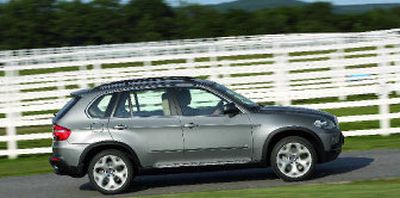BMW proves its point with this rig

BMW’s product planners thought they’d sell 260,000 copies of their first-generation X5 SUV.
They must have transposed a number because they wound up building 618,000.
Better to miss on the low side, I presume.
Predictably, the success of the X5 provoked a long list of competitors. BMW now responds with an all-new, 2007 X5, which is available in six- and eight-cylinder iterations.
The six-cylinder 3.0si is priced from $46,595, including destination; the 4.8i V-8 starts at $55,195.
Both come standard with BMW’s xDrive all-wheel-drive system.
The Holy Grail
You can’t do a midsize SUV these days without third-row seating. It’s the Holy Grail of the modern SUV.
The first-generation X5 lacked it. So the ‘07 grows by 7.4 inches in length and 2.5 inches width. That adds enough room for a pair of optional third-row seats and enough cargo space to be competitive with some full-size rigs.
A bigger footprint — wheelbase length is up 4 inches, from 111 to 115 inches — gives the X5 a smoother ride and more stability for towing. Equipped with the up-level, 350-horsepower, 4.8-liter V-8, it will tow 6,000 pounds.
You need a keen sense of observation to spot the size increase with the naked eye. In fact, the X5 looks more like the smaller X3 than before.
Aggressive use of aluminum, magnesium and other lightweight materials keeps the curb weight on par with last year, at just less than 5,000 pounds.
The interior is warmer and classier than before, with upgraded materials and new color and trim choices. The new exterior dimensions produce a roomier cabin, with greater leg, hip and shoulder room, and the new shift controller opens up new space on the console for larger cupholders and increased storage.
New Technologies
A new host of technologies, previously introduced on its sedan siblings, is now available on the X5. For better and for worse the iDrive control interface makes its first appearance here in a BMW SUV. Fortunately, it is greatly improved (which is to say simplified) over previous versions and, better yet, an entirely new iDrive system is said to be on the way.
From the 7-Series comes the shift-by-wire, console-mounted gear selector. It offers a choice of Reverse, Neutral and Drive while a button on top engages Park. Three drive modes include Drive, Sport and Manual. In Manual mode, the driver can use the lever or steering wheel-mounted paddles to select from among the six gears.
The six-speed manual available on the first edition is history, due to a lack of takers.
A host of new options include Active Steering, Active Roll Stabilization and Electronic Damping Control. All have previously appeared on sedans.
Sport-Sedan Performance
When the original was launched seven years ago, a 5,000-pound SUV with sport-sedan ride and handling was considered unlikely, if not impossible. Now it’s fact — and, despite its 8.3 inches of ground clearance, the new one is better than the old one.
A suspension overhaul includes BMW’s first-ever double wishbone, multi-link front suspension. By allowing greater flexibility in shock tuning and suspension geometry, it significantly improves ride and handling.
The proof of concept lay in a warren of narrow, twisting roads outside BMW’s plant in Spartanburg, S.C.: Set a line and the X5 tracks without complaint. Overcook it, and Dynamic Stability Control steps in to put things right.
DSC can be defeated via a dash-mounted switch but is instantly reinstated when the yaw rate reaches a preset level. On a skid pad at the test track, DSC instantaneously and continuously braked and drew power from slipping wheels, simultaneously applying it to those that still had traction.
There is no overriding the laws of physics, of course, and an overly enthusiastic driver can put even the X5 in the ditch.
It is a marvel, though, how 5,000 pounds of metal, rubber and plastic can be persuaded to change directions at speed and without warning. Order the Sport package, with 19-inch wheels and Adaptive Drive, which marries stability control and automatic shock absorber damping, and the results are even more impressive.
Engine Choices
BMW’s newest inline six-cylinder engine makes its debut in the X5. It features aluminum/magnesium composite construction and makes 260 hp — up 35 from last year — and 225 pound-feet of torque, up 11. It redlines at 7,000 rpm, versus its predecessor’s 6,500 rpm. It weighs less and enhances fuel efficiency by 1 mpg in town and 2 mpg on the highway.
The EPA rates it 17 mpg city/23 mpg highway.
Base price for the X5 3.0si is $46,595, including destination.
The X5 4.8i V-8 is a holdover but grows from 4.4 liters to 4.8 liters and adds 35 hp, to 350, and torque is up 26 to 350 pound-feet. Fuel efficiency drops by 1 mpg, in both city and highway driving, to 15/21.
BMW got the numbers all wrong with the first X5 but nailed the product. This time around, they improved the product and seem willing to let the numbers fall where they may. They’ve proved their point with this rig.